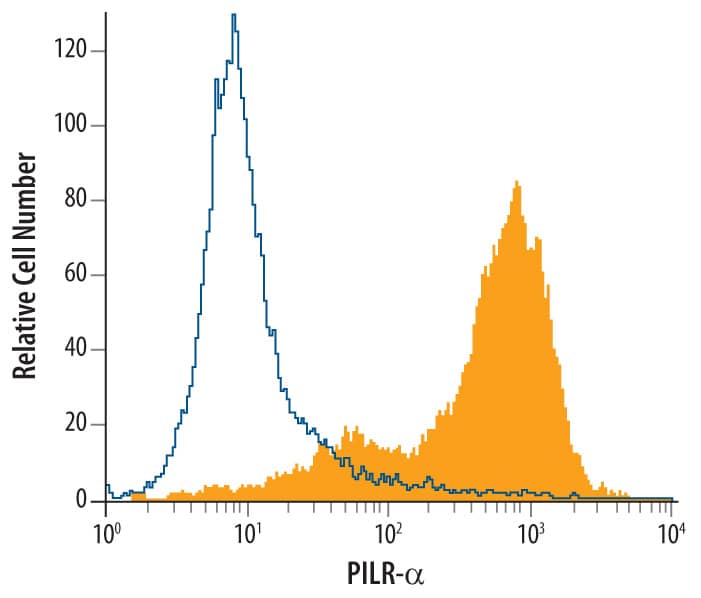Mouse PILR-alpha Antibody
R&D Systems, part of Bio-Techne | Catalog # AF4318


Key Product Details
Species Reactivity
Applications
Label
Antibody Source
Product Specifications
Immunogen
Leu21-Val197
Accession # Q2YFS3
Specificity
Clonality
Host
Isotype
Scientific Data Images for Mouse PILR-alpha Antibody
Detection of PILR‑ alpha in J774A.1 Mouse Cell Line by Flow Cytometry.
J774A.1 mouse reticulum cell sarcoma macrophage cell line was stained with Goat Anti-Mouse PILR-a Antigen Affinity-purified Polyclonal Antibody (Catalog # AF4318, filled histogram) or control antibody (Catalog # AB-108-C, open histogram), followed by Phycoerythrin-conjugated Anti-Goat IgG Secondary Antibody (Catalog # F0107).Applications for Mouse PILR-alpha Antibody
CyTOF-ready
Flow Cytometry
Sample: J774A.1 mouse reticulum cell sarcoma macrophage cell line
Western Blot
Sample: Recombinant Mouse PILR-alpha (Catalog # 4318-PR)
Formulation, Preparation, and Storage
Purification
Reconstitution
Formulation
Shipping
Stability & Storage
- 12 months from date of receipt, -20 to -70 °C as supplied.
- 1 month, 2 to 8 °C under sterile conditions after reconstitution.
- 6 months, -20 to -70 °C under sterile conditions after reconstitution.
Background: PILR-alpha
PILR-alpha (paired immunoglobulin-like type 2 receptor-alpha; also namedFDF03) is one of two members of a small family of immunoregulatory Ig-superfamily receptors (1, 2). It is a counterpart to PILR-beta and it likely gave rise to PILR-beta through gene duplication and rearrangement (1). The PILRs represent one of many pairs of Ig-like domain-containing receptors that participate in immune regulation. PILR-alpha and -beta should not be confused with the similarly named PIRs (also paired immunoglobulin‑like receptors), or the functionally-related SIRP and ILT/LILR/CD85/LIR family of receptors (2). While PIRs, ILTs and SIRPs contain three to six Ig‑like domains in their extracellular region, PILR-alpha and -beta show only one Ig-like region in their extracellular domain (ECD) (1, 2). Mouse PILR-alpha is a monomeric, 271 amino acid (aa) type I transmembrane (TM) protein (3). It contains a 167 aa ECD, a 21 aa TM segment, and a long, 83 aa cytoplasmic region. The ECD shows one V‑type Ig-like domain between aa 39 - 157, while the cytoplasmic region contains two ITIMs (immunoreceptor Tyr-based inhibitory motifs) between aa 265-270 and 294‑299. Given that ITIMs are known to interact with phosphatases such as PTPN6 and PTPN11, the presence of these motifs makes mouse PILR-alpha an inhibitory receptor. In human, activation of PILR-alpha inhibits CD32/Fc gammaRII-induced calcium mobilization (3). Although CD99 is a known ligand for both PILR-alpha and -beta (4), highest affinity binding seems to occur between CD99 and PILR-alpha (4). Mouse PILR-alpha is found on neutrophils and macrophages (4). Mouse PILR-alpha ECD is 43% and 69% aa identical to human and rat PILR-alpha ECD, respectively; it is 75% aa identical to the ECD of mouse PILR-beta (3). One potential isoform of PILR-alpha has been reported. It varies only within the first 28 aa of the signal sequence (5).
References
- Wilson, M.D. et al. (2006) Physiol. Genomics 27:201.
- Lanier, L.L. (2001) Curr. Opin. Immunol. 13:326.
- Fournier, N. et al. (2000) J. Immunol. 165:1197.
- Shiratori, I. et al. (2004) J. Exp. Med. 199:525.
- SwissProt # Q2YFS3.
Long Name
Alternate Names
Gene Symbol
UniProt
Additional PILR-alpha Products
Product Documents for Mouse PILR-alpha Antibody
Product Specific Notices for Mouse PILR-alpha Antibody
For research use only